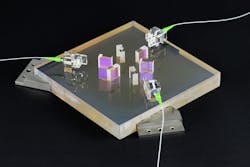Earth-based high-precision bench will test space-based LISA gravitational-wave-detection technology
It is now possible, on Earth, to test laser measurement technology for the planned Laser Interferometer Space Antenna (LISA) in laboratories almost under mission conditions. A team of researchers led by the Max Planck Institute for Gravitational Physics (Albert Einstein Institute; AEI) and the Institute for Gravitational Physics at Leibniz Universität in Hannover, Germany achieved the breakthrough with a novel experiment.1 The work ties up with the LISA Pathfinder mission, which tested LISA technologies in space from 2015 to 2017.
LISA is a planned observatory in space that will detect gravitational waves inaccessible on Earth. A consortium of international scientists is currently developing LISA as a mission of the European Space Agency (ESA). With their experiment, the AEI scientists can demonstrate the functionality of the LISA phasemeter, which will be the central measuring unit of the observatory. Their experiment can also be easily extended for further testing and can thus verify other steps of LISA measurements observatory.
LISA is scheduled to launch into space in 2034 as a mission of the European Space Agency (ESA). The mission will consist of three satellites that will create an equilateral laser triangle with each side approximately 2.5 million km long. The distances of this formation flight in space are changed by on the order of a picometer by gravitational waves.
To detect these changes, phasemeters in the LISA satellites monitor and measure the laser light exchanged between them. This measurement has to be performed with highest precision over a large range of 8 to 10 orders of magnitude.
In their article, the researchers describe a new experimental setup that enables laser-based LISA measurements in a laboratory under almost realistic mission conditions and use it to verify the accuracy of the phasemeter. The setup consists of an optical bench which, due to its construction, is highly precise and stable and thus eliminates all undesirable noise sources ten times better than previous experiments. The required LISA accuracy in the picometer range can thus be achieved.
On the optical bench, three laser beams produced in a controlled manner are superimposed in pairs in order to obtain six new laser beams with precisely defined properties. By skillfully superimposing three of these mixed beams and measuring their properties with the phasemeter, its function can be precisely checked.
Zerodur baseplate
The setup, which consists of a Zerodur baseplate with three fiber-injector optical subassemblies, six wedged beamsplitters, and photoreceivers, will test for noise as well as for phase-extraction linearity.
LISA will measure low-frequency gravitational waves with oscillation periods from 10 seconds to more than half a day, which cannot be observed with detectors on Earth. Such gravitational waves are emitted, for example, by supermassive black holes, millions of times heavier than the Sun, that merge at the centers of galaxies, the orbital movements of tens of thousands of binary stars in our Galaxy, and possibly from exotic sources such as cosmic strings and the echo of the Big Bang.
Between December 2015 and July 2017, the LISA Pathfinder mission demonstrated other LISA components in space and showed that they exceeded requirements throughout the LISA measurement band.
ESA is currently conducting the Phase A system study with the international LISA consortium. A preliminary design of the space components is to be developed in preparation for the mission.
Source: https://www.aei.mpg.de/57830/a-high-precision-test-bench-for-lisa-technology?c=26160
REFERENCE:
1. Thomas S. Schwarze et al., Physical Review Letters (2019); https://link.aps.org/doi/10.1103/PhysRevLett.122.081104

John Wallace | Senior Technical Editor (1998-2022)
John Wallace was with Laser Focus World for nearly 25 years, retiring in late June 2022. He obtained a bachelor's degree in mechanical engineering and physics at Rutgers University and a master's in optical engineering at the University of Rochester. Before becoming an editor, John worked as an engineer at RCA, Exxon, Eastman Kodak, and GCA Corporation.
